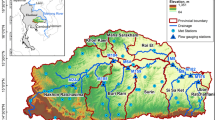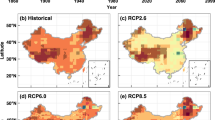Abstract
Agricultural systems in low-income food-deficit countries face considerable risks from climate extremes and geopolitical tensions. Here, using remote sensing and meteorological observations, we show that the Democratic People’s Republic of Korea exhibits lower agricultural drought resistance than the Republic of Korea under meteorological droughts of similar severity. Energy shortages, exacerbated by trade sanctions, have limited the Democratic People’s Republic of Korea’s irrigation capacity, further impairing its drought resistance and food security.
This is a preview of subscription content, access via your institution
Access options
Access Nature and 54 other Nature Portfolio journals
Get Nature+, our best-value online-access subscription
$32.99 / 30 days
cancel any time
Subscribe to this journal
Receive 12 digital issues and online access to articles
$119.00 per year
only $9.92 per issue
Buy this article
- Purchase on SpringerLink
- Instant access to full article PDF
Prices may be subject to local taxes which are calculated during checkout


Similar content being viewed by others
Data availability
The TerraClimate dataset is available at https://www.climatologylab.org/terraclimate.html. The Climate Hazards Group InfraRed Precipitation with Station is available at https://chc.ucsb.edu/data/chirps. The Integrated Multi-satellitE Retrievals for GPM is available at https://disc.gsfc.nasa.gov/datasets/GPM_3IMERGM_07/summary?keywords=GPM_3IMERGM_07. The CSIF dataset used in the analysis is available via figshare at https://doi.org/10.6084/m9.figshare.6387494.v2 (ref. 32). The MCD43A4 Collection 6 dataset is available at https://lpdaac.usgs.gov/products/mcd43a4v006/. The annual maps of rice crops are available from ref. 31. All statistical data used in the study (such as cropland equipped for irrigation, water use efficiency, fertilizer imports and coal imports) can be found via GitHub in the Excel file Data_Statistics.xlsx at https://github.com/QiangHHZ/Sanctions-Drought-Korea/blob/main/Data/Data_Statistics.xlsx. A detailed description and active links for each statistical variable are provided in Supplementary Table 1. Source data are provided with this paper.
Code availability
All the scripts for the data analyses and visualization are available via GitHub at https://github.com/QiangHHZ/Sanctions-Drought-Korea/tree/main/Codes.
References
Godfray, H. C. J. et al. Food security: the challenge of feeding 9 billion people. Science 327, 812–818 (2010).
Trenberth, K. E. et al. Global warming and changes in drought. Nat. Clim. Change 4, 17–22 (2014).
Li, X.-Y. et al. Civil war hinders crop production and threatens food security in Syria. Nat. Food 3, 38–46 (2022).
Puma, M. J. Resilience of the global food system. Nat. Sustain. 2, 260–261 (2019).
Kinnunen, P. et al. Local food crop production can fulfil demand for less than one-third of the population. Nat. Food 1, 229–237 (2020).
Xu, Z. et al. Impacts of international trade on global sustainable development. Nat. Sustain. 3, 964–971 (2020).
Zhang, C., Chen, X., Li, Y., Ding, W. & Fu, G. Water–energy–food nexus: concepts, questions and methodologies. J. Clean. Prod. 195, 625–639 (2018).
Balasubramanian, M. Climate change, famine, and low-income communities challenge Sustainable Development Goals. Lancet Planet. Health 2, e421–e422 (2018).
McCurry, J. No end in sight for North Korea’s malnutrition crisis. Lancet 379, 602 (2012).
Ryu, J.-H. et al. Different agricultural responses to extreme drought events in neighboring counties of South and North Korea. Remote Sens. 11, 1773 (2019).
Yu, C.-A. The rise and demise of industrial agriculture in North Korea. J. Korean Stud. 12, 75–109 (2007).
Shi, Y. et al. Building social resilience in North Korea can mitigate the impacts of climate change on food security. Nat. Food 3, 499–511 (2022).
Kim, K. S. North Korea’s Petroleum Industry-Facilities, Demand/Supply, Distribution and UN Sanctions Report No. 3569472 (Korea Energy Economics Institute, 2019); https://doi.org/10.2139/ssrn.3569472
Wertz, D. The evolution of financial sanctions on North Korea. N. Korean Rev. 9, 69–82 (2013).
Gunjal, K. et al. FAO/WFP Crop and Food Security Assessment Mission to the Democratic People’s Republic of Korea (FAO, 2013); http://www.fao.org/3/a-az424e.pdf
Zhao, W. et al. Impacts of extreme climate events on future rice yields in global major rice-producing regions. Int. J. Environ. Res. Public Health 19, 4437 (2022).
Lim, C.-H., Kim, S. H., Chun, J. A., Kafatos, M. C. & Lee, W.-K. Assessment of agricultural drought considering the hydrological cycle and crop phenology in the Korean Peninsula. Water 11, 1105 (2019).
Zhang, Y., Joiner, J., Alemohammad, S. H., Zhou, S. & Gentine, P. A global spatially contiguous solar-induced fluorescence (CSIF) dataset using neural networks. Biogeosciences 15, 5779–5800 (2018).
Von Hippel, D. & Hayes, P. Energy security for North Korea. Science 316, 1288–1289 (2007).
Keough, J. et al. The impact of sanctions on North Korea. Asia Policy 13, 1–48, (2018).
Chung, H. et al. Evaluation of disease resistance of rice cultivar developed in North Korea. Res. Plant Dis. 25, 108–113 (2019).
Zhu, K. et al. Divergences in leaf CO2 diffusion conductance and water use efficiency of soybean coping with water stress and its interaction with N addition. Environ. Exp. Bot. 217, 105572 (2024).
Fankhauser, S. & McDermott, T. K. J. Understanding the adaptation deficit: why are poor countries more vulnerable to climate events than rich countries? Global Environ. Change 27, 9–18 (2014).
Lesk, C., Rowhani, P. & Ramankutty, N. Influence of extreme weather disasters on global crop production. Nature 529, 84–87 (2016).
Han, Z. et al. Long-chain propagation pathways from meteorological to hydrological, agricultural and groundwater drought and their dynamics in China. J. Hydrol. 625, 130131 (2023).
West, H., Quinn, N. & Horswell, M. Remote sensing for drought monitoring & impact assessment: progress, past challenges and future opportunities. Remote Sens. Environ. 232, 111291 (2019).
McKee, T. B., Doesken, N. J. & Kleist, J. The relationship of drought frequency and duration to time scales. In Proc. 8th Conference on Applied Climatology Vol. 17, 179–183 (AMS, 1993).
Abatzoglou, J. T., Dobrowski, S. Z., Parks, S. A. & Hegewisch, K. C. TerraClimate, a high-resolution global dataset of monthly climate and climatic water balance from 1958–2015. Sci. Data 5, 170191 (2018).
Funk, C. et al. The climate hazards infrared precipitation with stations—a new environmental record for monitoring extremes. Sci. Data 2, 150066 (2015).
Huffman, G. J. et al. NASA Global Precipitation Measurement (GPM) Integrated Multi-satellitE Retrievals for GPM (IMERG). Algorithm Theoretical Basis Document (ATBD) Version 6 (2020); https://gpm.nasa.gov/sites/default/files/2020-05/IMERG_ATBD_V06.3.pdf
Zhang, G. et al. Fingerprint of rice paddies in spatial–temporal dynamics of atmospheric methane concentration in monsoon Asia. Nat. Commun. 11, 554 (2020).
Zhang, Y. CSIF. figshare https://doi.org/10.6084/m9.figshare.6387494.v2 (2018).
Acknowledgements
We acknowledge support from the National Natural Science Foundation of China (grant nos. 42271375, J.D.; 42461144212, J.D.), and the Youth Interdisciplinary Team Project of the Chinese Academy of Sciences (grant no. JCTD-2021-04, J.D.). We thank Y. Ryu at Seoul National University, X. He at the National University of Singapore, G. Zhang at the China Agricultural University and N. You at the Chinese Academy of Sciences for their valuable comments in the initial stage of this study and for editing the paper.
Author information
Authors and Affiliations
Contributions
J.D., Q.Z. and Q.G. conceptualized and designed the study. Q.Z. collected and processed the data, performed the analysis, constructed the figures and wrote the initial paper. S.G. and S.H. assisted in the analysis of long-chain drought propagation. All authors contributed to writing, reviewing and editing the paper.
Corresponding authors
Ethics declarations
Competing interests
The authors declare no competing interests.
Peer review
Peer review information
Nature Food thanks David Von Hippel and the other, anonymous, reviewer(s) for their contribution to the peer review of this work.
Additional information
Publisher’s note Springer Nature remains neutral with regard to jurisdictional claims in published maps and institutional affiliations.
Extended data
Extended Data Fig. 1 Temporal dynamics of key variables influencing rice yield in the DPRK and ROK.
a, Rice yield in the DPRK and ROK since 1995, with coefficient of variation (CV) values for the both countries. b–e, Comparisons of irrigation capacity, including cropland equipped for irrigation, total dam capacity, water use efficiency of irrigation agriculture (WUE), and water consumption coefficient. Agricultural irrigation WUE represents the Gross Value Added per unit of water used (expressed in dollars/m3) of the agricultural irrigation sector. f, Changes in electricity generation in the DPRK and ROK since 1980. g, Changes in coal production in the DPRK and ROK since 1980. h–i, Comparisons of energy imports, including crude oil and coal, in the DPRK and ROK since 1980. Gray vertical dashed lines in b–i correspondingly indicate the dissolution of the Soviet Union (1991) and the onset of sanctions on the DPRK due to its nuclear program (2006).
Supplementary information
Supplementary Information
Supplementary Texts 1–7, Figs. 1–32 and Tables 1–4.
Source data
Source Data Fig. 1
Statistical source data.
Source Data Fig. 2
Statistical source data.
Source Data Extended Data Fig. 1
Statistical source data.
Rights and permissions
Springer Nature or its licensor (e.g. a society or other partner) holds exclusive rights to this article under a publishing agreement with the author(s) or other rightsholder(s); author self-archiving of the accepted manuscript version of this article is solely governed by the terms of such publishing agreement and applicable law.
About this article
Cite this article
Zhang, Q., Dong, J., Xu, Z. et al. Energy shortages undermine agricultural drought resistance in the Democratic People’s Republic of Korea. Nat Food (2025). https://doi.org/10.1038/s43016-025-01226-8
Received:
Accepted:
Published:
DOI: https://doi.org/10.1038/s43016-025-01226-8



